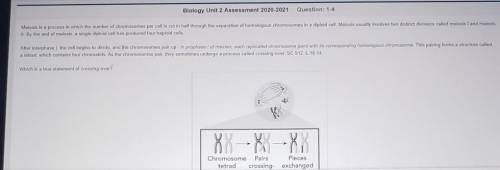
Biology, 14.12.2020 17:50 malikbryant2002
A. Crossing over decreases genetic diversity
B. During crossing-over, bits and pieces of the homologous chromosomes are exchanged
C. Homologous chromosomes move to opposite ends of dividing cells
D. The DNA of the diploid cell is copied


Answers: 1


Other questions on the subject: Biology


Biology, 22.06.2019 12:30, DisneyyKayy
Gram-negative bacteria have a cell wall that is! and does not accept the stain, making itappear
Answers: 2


Biology, 22.06.2019 23:30, kutemigos9211
Enzymes are both ph and temperature specific. seen here are the reaction rates of three common digestive enzymes. based on the data, which enzyme's optimum activity occurs in a basic environment while another's is very acidic?
Answers: 1
You know the right answer?
A. Crossing over decreases genetic diversity
B. During crossing-over, bits and pieces of the homolo...
Questions in other subjects:


English, 25.03.2020 23:20






Mathematics, 25.03.2020 23:21


Mathematics, 25.03.2020 23:21



